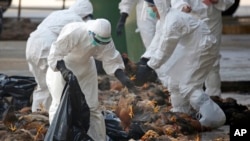The World Health Organization says it has noticed mutations in the bird flu virus now spreading in China, but says the risk of the disease spreading easily between people remains low.
In a press briefing Wednesday, the U.N. health agency said in about 7 percent of the people infected with the H7N9 strain of bird flu, scientists have identified genetic changes suggesting the viruses are resistant to Tamiflu, the recommended treatment for the disease and the drug that is being stockpiled worldwide in preparation for a flu pandemic.
Wenqing Zhang, head of WHO's flu department, said the rate is similar to what has been picked up in previous years.
"Constant change is the nature of all influenza viruses," she said. Zhang said that the resistant viruses were detected in people who had already been treated with Tamiflu, allaying fears that the virus might be spontaneously acquiring resistance in the wild.
Zhang said mutations in the H7N9 virus have also made it more deadly to birds, but he says it's unclear what that might mean for humans.
Other experts said that the increased danger of H7N9 to birds would at least make the disease easier to spot in poultry, allowing officials to react quicker.
"The question is, does this change in the virus' lethality make it any more lethal for humans? The jury is still out on that," said Wendy Barclay, chair of influenza at Imperial College London.
Although bird flu cases have surged this year, Barclay said there was no suggestion the virus is adapting more easily to human transmission. "Based on the genetic sequences of the viruses, there are no changes to suggest this is about to explode into a pandemic," Barclay said.
Some scientists have raised concerns about whether China is sharing enough information; earlier this year, the country suddenly announced about 100 cases, a lag that could compromise efforts to track any changes in the virus' spread.
"We always need more and better information faster," said Michael Osterholm of the University of Minnesota, adding that the continuing bird flu worries underline the world's vulnerability to the next flu pandemic.
"We are not in any better position to respond than we were during the (2009) swine flu pandemic," he said.







